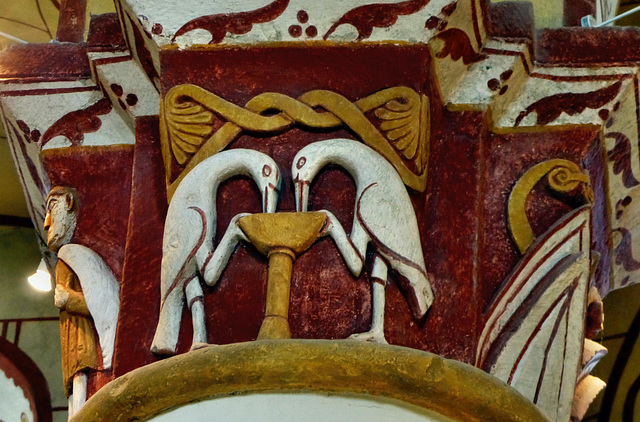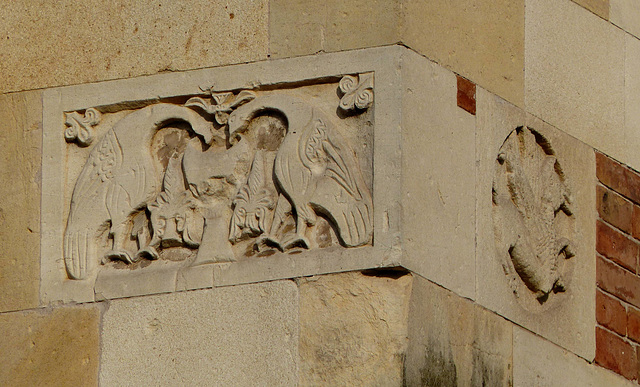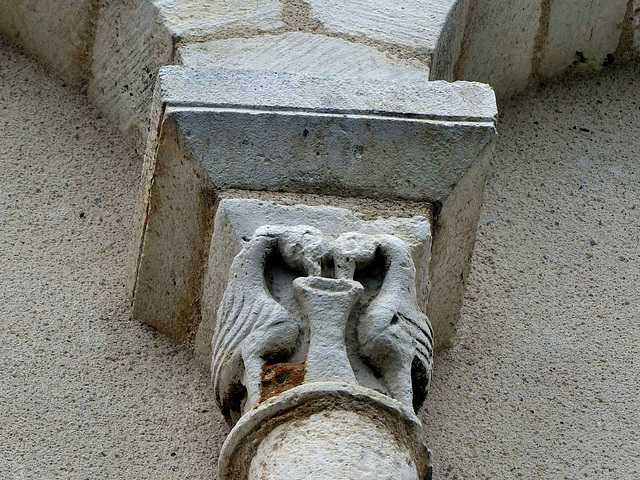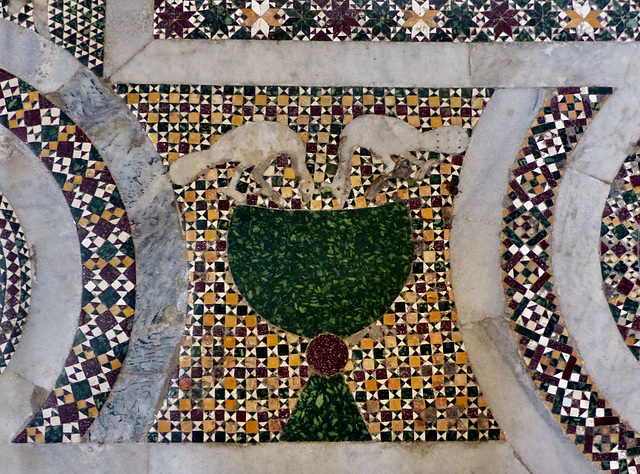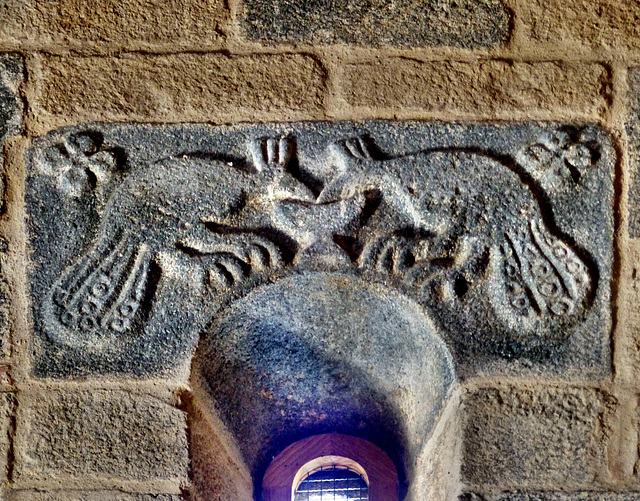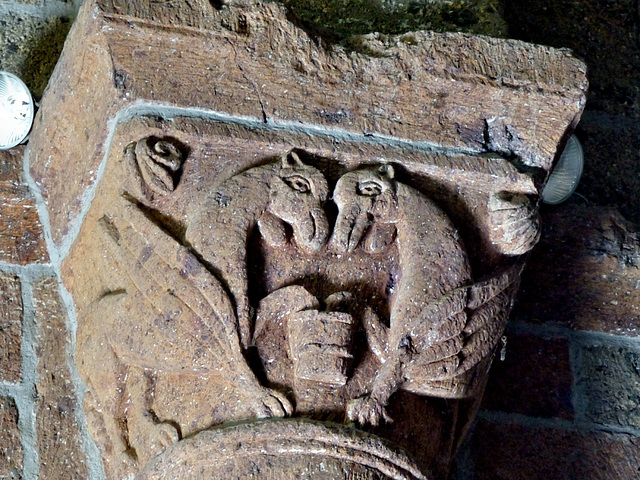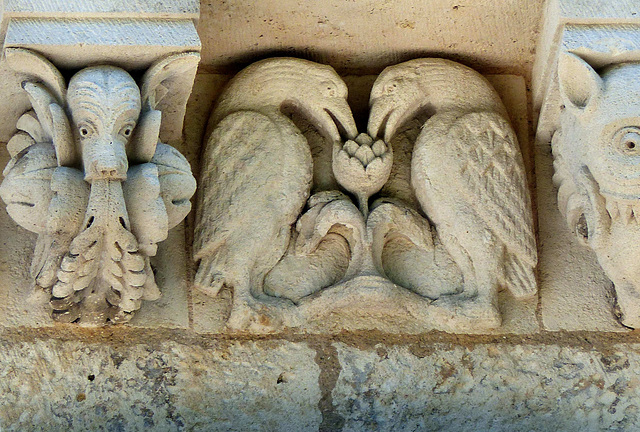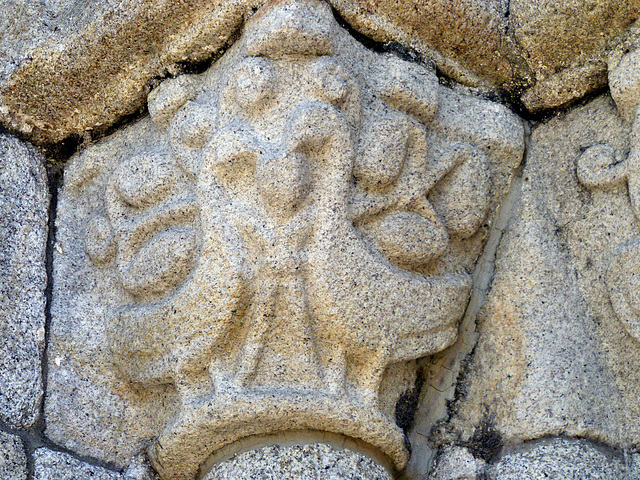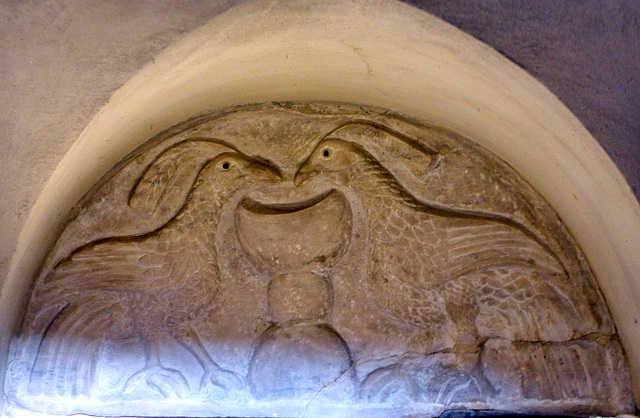
Birds drinking from a chalice
Birds or griffins (or even deers!) drinking from a chalice, cup or foutain is a symbol, that existed already in pre-Christian time.
Civaux - Saint Gervais et Saint Protais
Civaux, a village with a population of about 1000, has a history rooting very deep. Humans populated the area already, when stepp bisons and mammoths were hunted. Many "pre-historic" artefacts have been excavated in and around Civaux, proving that this place was inhabited over tens of thousands of years.
A settlement stood on the site of the village in Gallo-Roman times, and there are still traces of Roman temples. Excavations have revealed the sites of a theater (capacity 3000), a fortified camp, and the foundations of many villas.
This has been a place of very early christianisation. A funeral stele has been found dating to around 400, a pagan temple and a very early baptisterium were excavated next to the church. A polygonal apse was probably built as will around 400, what actually means that this church, dedicated to Saint Gervais and Saint Protais is one of the oldest in France.
At that time a kind of pilgrimage must have developed. The relics of Saint Gervais and Saint Protais had been miraculously discovered by Saint Ambrose in Milan in 386, so the saints got very popular in Merovingian times, but that does not explain the enigma of Civaux. The village stands in the center of a huge merovingian necropolis.
As many sarcophagi were sold as water basins or troughs in later time, the exact number of graves is unknown. Serious estimations are between 15.000 and 20.000 graves.
There are parallels to nearby Saint Pierre in Cauvigny (16 kms north). The same colours as in Chauvigny were used here during the restauration of the interior. At least one of the capitals is very similar to one in Saint Pierre, but some carvings are absolutely unique. The nave dates back to the 11th century, the apse more than 600 years older.
Two birds drinking from a chalice ("Communion cup") probably a symbol for the Eucharist. This icon can often be found in Ronanesque churches. Sometimes there are griffons instead of birds.
Verona - Santo Stefano
A church, dedicated to "Santo Stephano", was erected in a cemetery area, outside the city walls within the 5th century. The church underwent a couple of enlargements, buildings and renovations, so that most, what is seen from here is probably 11th century.
This relief is on the right corner of the facade.
Two birds drinking from a chalice.
Saint-Gaultier - Saint-Gaultier
In 1040, the Count de la Marche and the Lord of Chabanais looted and burned down the abbey of Lesterps (Charente). Abbot Gaultier, who was absent during the incident, placed a complaint in Rome, so that the two criminals got excommunicated. In reparation, the Count de la Marche had to provide for the costs of rebuilding the abbey. The Lord of Chabanais had to donate land he owned at the time in Berry
At this land, a church dedicated to Abbé Gaultier was built end of the 11th century for the priory that existed. The village, that developed was named as well after Abbé Gaultier, who died in 1070, and was canonized just three years later.
There are some interesting carvings around the apse.
Two birds drinking from a chalice.
Palermo - Martorana
Sicily, the largest Mediterranean island, has a long history, that starts around 8000 BC, but later there were Phoenician, Carthaginian, Greek and Roman periods. After the Roman Empire had fallen apart the Vandals tried to take over the island but failed. Finally, the Ostrogoths took possession.
Mid of the 6th century Sicily was conquered by troops of the Byzantine Empire. After the advent of Islam, Sicily got attacked by the Arab forces. Raids seeking loot continued until the mid-8th century.
A Muslim army was sent to the island in 827 but met with much resistance. So it took a century to conquer it and even later revolts constantly occurred
In 1038 the Byzantines invaded the island supported by Norman mercenaries, led by Roger. In 1072, after the siege of Palermo, most of Sicily was under Norman control. Roger´s son Roger II raised the status of the island to a kingdom in 1130. During this period, the Kingdom of Sicily was prosperous and powerful,
The court of Roger II became melting out of culture from Europe and the Middle East. This attracted scholars, scientists, artists, and artisans. Muslims, Jews, Greeks, Lombards, and Normans cooperated and created some extraordinary buildings.
In 1186 the last descendant of Roger, Constance of Sicily married Emperor Henry VI, the second son of Barbarossa. So the crown of Sicily was passed on to the Hohenstaufen Dynasty. Frederick II, the only son of Constance, was crowned King of Sicily at the age of four in 1198. He became "Stupor Mundi", one of the greatest and most cultured men of the Middle Ages.
Palermo, founded in 734 BC by the Phoenicians, became a possession of Carthage and later was part of the Roman Empire. From 831 to 1072 the city was under Arab rule. Following the Norman conquest, Palermo became the capital of a new Kingdom of Sicily and the capital of the Holy Roman Empire under Emperor Frederick II and King Conrad IV.
The Martorana, overlooking the Piazza Bellini, is located next to the "Chiesa de San Cataldo" (right). The church is as well known under the name "Santa Maria dell’Ammiraglio" and serves the Italo-Albanian parish of San Nicolò dei Greci, who officiate the liturgy according to the Byzantine Rite in the ancient Greek language.
The church was founded by (Syrian) George of Antioch, Ammiratus (Admiral) of Rogers II of Sicily, and built in 1143. Originally it was built over the layout of a Greek cross-in-square, but it has undergone numerous structural changes and additions throughout history. In 1435 the church was annexed to the Benedictine convent of Eloisia Martorana.
The interior of the church is breathtaking. During the iconoclasms the Byzantine Iconoclasms (730-850) Byzantine craftsmen and artists settled and worked in the west (eg Ravenna, Rome..). These mosaics were created by these artists.
The floor as well is decorated in "cosmatesque" style . Here "two birds drinking from a chalice, an Eucharistic symbol, associated with Baptism and Resurrection.
Because of its richness, the church was visited, in the late 12th century, by the Arab traveller Ibn Jubayr, who left a detailed description of the church, defined as “the most beautiful monument in the world”.
Aregno - Trinita e San Giovanni Battista
The island of Corsica is one of the 18 regions of France. It was colonized the Carthaginians, the Greeks, the Etruscans and the Romans. After the Roman empire collapsed, Corsica got invaded by the Vandals and the Ostrogoths. For a short while the island belonged to the Byzantine Empire, then the Franks granted the island to the Pope, in the early 11th century Pisa and Genoa together freed the island from the threat of Arab invasion. The island came under the influence of the Republic of Pisa, later it belonged to Genua for centuries. In 1755 after a long fight for independence from Genoa the independent Corsican Republic was proclaimed, but in 1769, when the island was conquered by France. As the areas near the coast over centuries have been threatened by attacks and raids of pirates many old hamlets and dwellings are wide inland, high in the mountains. So most of the old churches are in the mountains and some of them are hard to find.
Archeologists proved, that Aregno was occupied already in Roman times and was a regional center of the surrounding hamlets in medieval times. It is known for this church. "Trinita e San Giovanni Battista", located in the center of the graveyard, is a former "pieve" (parish church) erected in the first half of the 12th century. This is a "Pisan style" single nave church 16.60 mx 6.30 m, with a semicircular apse circular and a spectacular facade with extraordenary carvings.
The nave does not look spectacular on first sight. Just like at the outside wall peacocks embellish the window frame inside, but there is a difference. Here the two peacocks drink from a chalice, a motif, that stemms from Greek, Roman, Byzantine and Sassanian sources.
In Christianity it developed into an Eucharistic symbol, associated with Baptism and Resurrection.
Le Monastier-sur-Gazeille - Saint Chaffre
As I have taken already so many photos of Saint Chaffre over the years, I will only add two know
Legends tell, that a small community of hermits lived here in the 6th century. A century later the group was led by (Saint) Eudes and after him by Eudes´ nephew (Saint) Theofrede. Theofrede got killed by the locals - and so he became a martyr named Saint Chaffre.
The monastery adopted the Benedictine rule in 817 and found support from Louis the Pious. In the following two centuries three churches were erected here. All collapsed due to the unstable ground. The current, former abbey church was built from 1074 on.
The monastery (and the relics of Saint Chaffre) were just a day´s walk from Le Puy, where the Via Podiensis started and many pilgrims gathered. It may well be, that the wealthiness of the abbey, was related to the pilgrim-business.
Here is one of the nave´s capitals. Two griffins drinking from a chalice.
Surgères - Notre-Dame
Notre-Dame de Surgères was erected in the center of a large castle in the 12th century. The fortification, founded in the 9th century as a motte, when the area was raided by the Vikings, then guarded the border of the historical province of Aunis once.
When the church was built a small town had developed around the defence already. Later a small priory and a "hopital" existed, as this was a halt on the Via Turonensis. The pilgrims had a lot to gape here, the facade is stunning 23 meters wide.
Eleanor of Aquitaine married Henry II of England in 1152, so the area changed hands and was ruled by the House of Plantagenet. During the Hundred Years' War Surgères experienced a long period of decline. Louis XI´s troops conquered the town in 1472 and the fortifications got destructed. During that time Notre Dame lost the tower and large parts of the nave, but not the facade!
There are more than 100 capitals and corbels all over the facade. There seems to be a medieval encyclopedia. Here are two birds, nibbling from a flower, probably a variation of the very common icon "birds drinking from a chalice".
Porto - São Martinho de Cedofeita
Porto is with a population of about 250.000 the largest city in Northern Portugal. In "Greater Porto", the metropolitan area, live even more than 1.7 million people.
The historical center of Porto was proclaimed a World Heritage Site by UNESCO in 1996. Port wine is named after Porto, since the cellars of Vila Nova de Gaia on the southern banks of the river Douro are the centers for packaging, transport and export of the fortified wine. Some years ago I had been here for a couple of days before I started the "Camino Portugues" here.
According to the tradition a monastery existed here within the 6th century. The church of today was consecrated in 1087, but it is proven that two buildings existed here already before.
The inscription carved into the tympanum states, that the church was founded in 559 by King Theodemar and consecrated by the Bishop of Braga Lucrécio, but the inscription was done in 1767.
I had learned that inside are two Pre-romanesque capitals, but the church was locked, but I could see the capitals that adorned the three portals of the church like this one: Two birds, drinking from chalice.
Milan - Basilica of Sant'Ambrogio
Milan is the city capital of the Lombardy and the second most populous city in Italy after Rome. Known during Roman times as "Mediolanum" it was the place, where in 313 Constantine I and Licinius met and "signed" the "Edict of Milan", giving Christianity a legal status within the Roman empire.
At the end of the Roman empire Milan was besieged by the Visigoths in 402, looted by the Huns in 452, and taken by the Ostrogoths in 539. Only 30 years later is belonged to the Kingdom of the Lombards, until in 774 Charlemagne defeated the Langobards and added Milan to the Carolingian empire. During Barbarossa´s (Frederik I) "Italian Campaigns" Milan was taken and destroyed to a great extent.
The "Basilica of Sant'Ambrogio" is much older and was not destroyed by Barbarossa´s troops. It is one of the most ancient churches in Milan, built by St. Ambrose in 379–386, outside the city of Milan on the site of a cemetery, where the martyrs of the Roman persecutions had been buried. The first name of the church was "Basilica Martyrum".
Ambrose, born into a noble family about 340 in (present-day) Trier (Germany), was governor of Liguria and Emilia for two years before he became the Bishop of Milan in 374 by popular acclamation. He was a staunch opponent of Arianism.
Only very few traces of the first church can still be found, as in the centuries after its construction, the basilica underwent numerous restorations and reconstructions. The current Romanesque church, mostly built in brickwork, was begun around 1080.
In 789, a Benedictine monastery was established here. The canons of the basilica, however, retained their own community. So two separate communities shared the basilica. In the 11th century, the canons adopted orders and became Canons Regular. From then on two separate monastic orders following different rules lived in the basilica. The canons were in the northern building, the cloister of the canons, while the monks were in the two southern buildings.
The two towers symbolize the division in the basilica. The 9th century Torre dei Monaci ("Tower of the Monks") tower was used by the monks. However, the canons did not have a bell tower and were not allowed to ring bells until they finished the Canons' bell tower in the 12th Century. This tower got two additional levels in 1889.
In 1943 the basilica got severely damaged by bombings. It took a decade to rebuilt and reconstruct the church.
The ambo stands on the left side of the nave. From here the monks and canons read the Gospel. The ambo, supported by nine slender ancient columns, was built over a 4th century sarcophagus, known as "Stilicho's Sepulchre", between 1130 and 1143. When the roof of the basilica collapsed in 1196, the ambo got severely damaged, but it got rebuilt already in 1201.
Between the ambo and the sarcophagus are some semicircular lunettes. They again differ style and in icons.
Two birds, drinking from a chalice is an icon going back to Greek, Roman, Byzantine and Sassanian sources.
In Christianity it developed into an Eucharistic symbol associated with Baptism and Resurrection.
Jump to top
RSS feed- Latest items - Subscribe to the latest items added to this album
- ipernity © 2007-2024
- Help & Contact
|
Club news
|
About ipernity
|
History |
ipernity Club & Prices |
Guide of good conduct
Donate | Group guidelines | Privacy policy | Terms of use | Statutes | In memoria -
Facebook
Twitter

